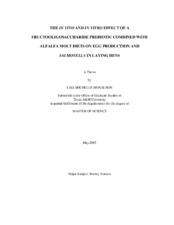| dc.description.abstract | Salmonellosis affects an estimated 1.4 million people a year with a great majority
of cases never being reported. Salmonella Enteritidis (SE) can be found in a variety of
foods including poultry meat and eggs. Susceptibility of SE colonization is increased by
molting.
Induced molting is used in the poultry industry to rejuvenate the hen??s
reproductive tract and increase post molt egg quality and production. The most common
molting method is complete feed withdrawal. Recent animal welfare pressures have
encouraged the industry to seek alternatives to feed withdrawal with one alternative
being feeding a high fiber diet like alfalfa. Alfalfa is high in protein, but low in energy
which is desirable for a molt diet. Alfalfa??s fermentation properties have been thought to
be an inhibitor in pathogen colonization during molting. Including a prebiotic such as
fructooligosaccharide (FOS) in the molt diet is thought to further decrease colonization
while benefiting the indigenous microflora.
Laying hens were molted using alfalfa combined with different ratios of layer
ration in an in vivo experiment. The hens responded comparably to the alfalfa molt dietsas they did to feed withdrawal as far as post-molt production parameters were
concerned, thus showing that alfalfa was a viable alternative molt diet.
Two in vitro studies were designed to evaluate the fermentation properties of
alfalfa and layer ration combined with the prebiotic FOS and their abilities to inhibit
Salmonella growth. Each treatment was combined with diluted cecal contents and
allowed to ferment. The results showed that the most fermentation occurred when
alfalfa was the substrate and was slightly increased with the addition of FOS. In
addition, combining FOS with alfalfa inhibited Salmonella growth.
To integrate these results, an in vivo study was preformed using an alfalfa/layer
ration diet from the previous in vivo study with FOS. Volatile fatty acids and lactic acid
measurements were made to evaluate fermentation while Salmonella colonization was
measured in pertinent organs and in fecal shedding. The results of this study further
substantiate alfalfa as a molt diet and conclude that the addition of FOS does, while not
statistically significant, further inhibit Salmonella colonization. | en |


